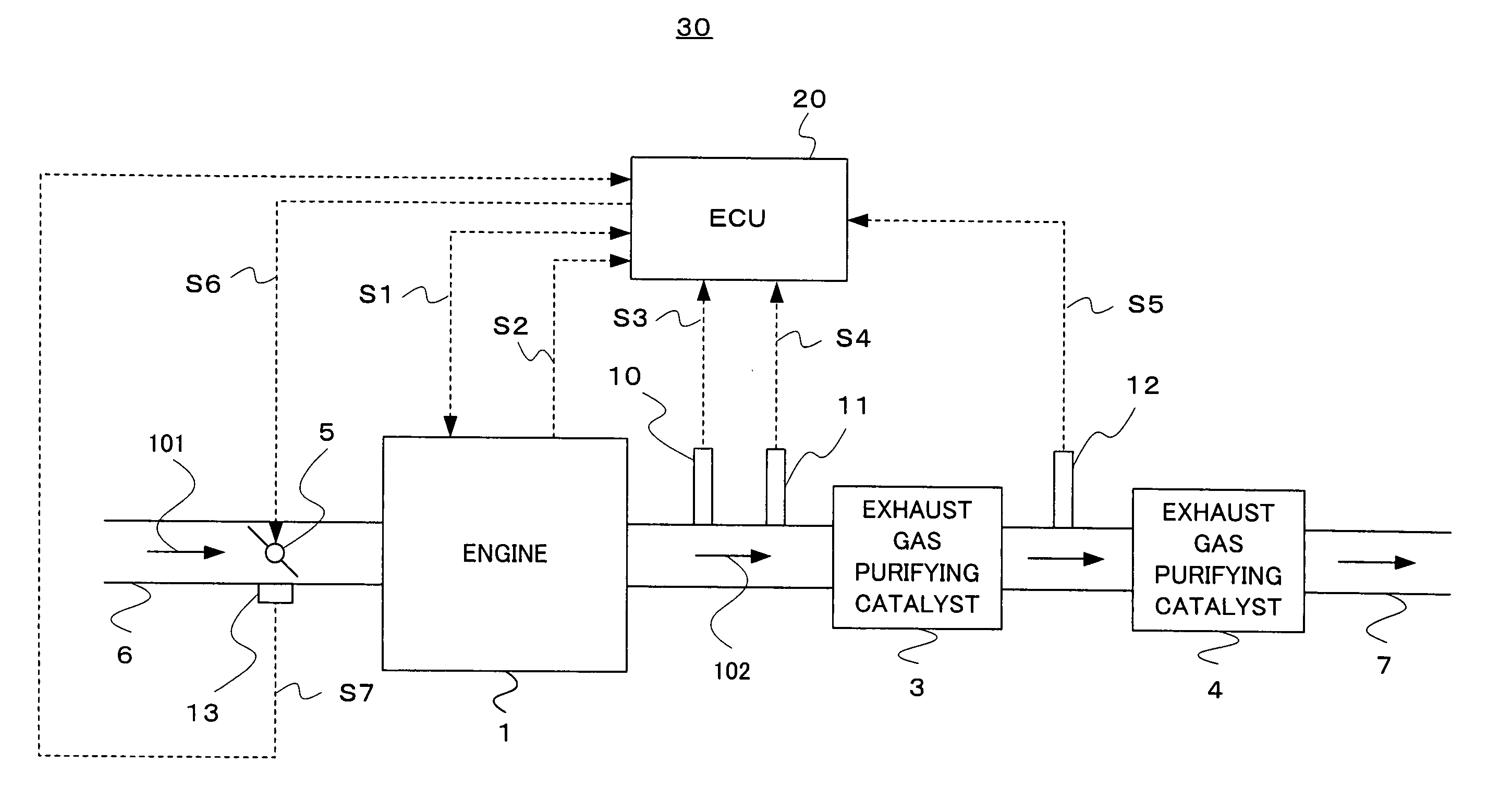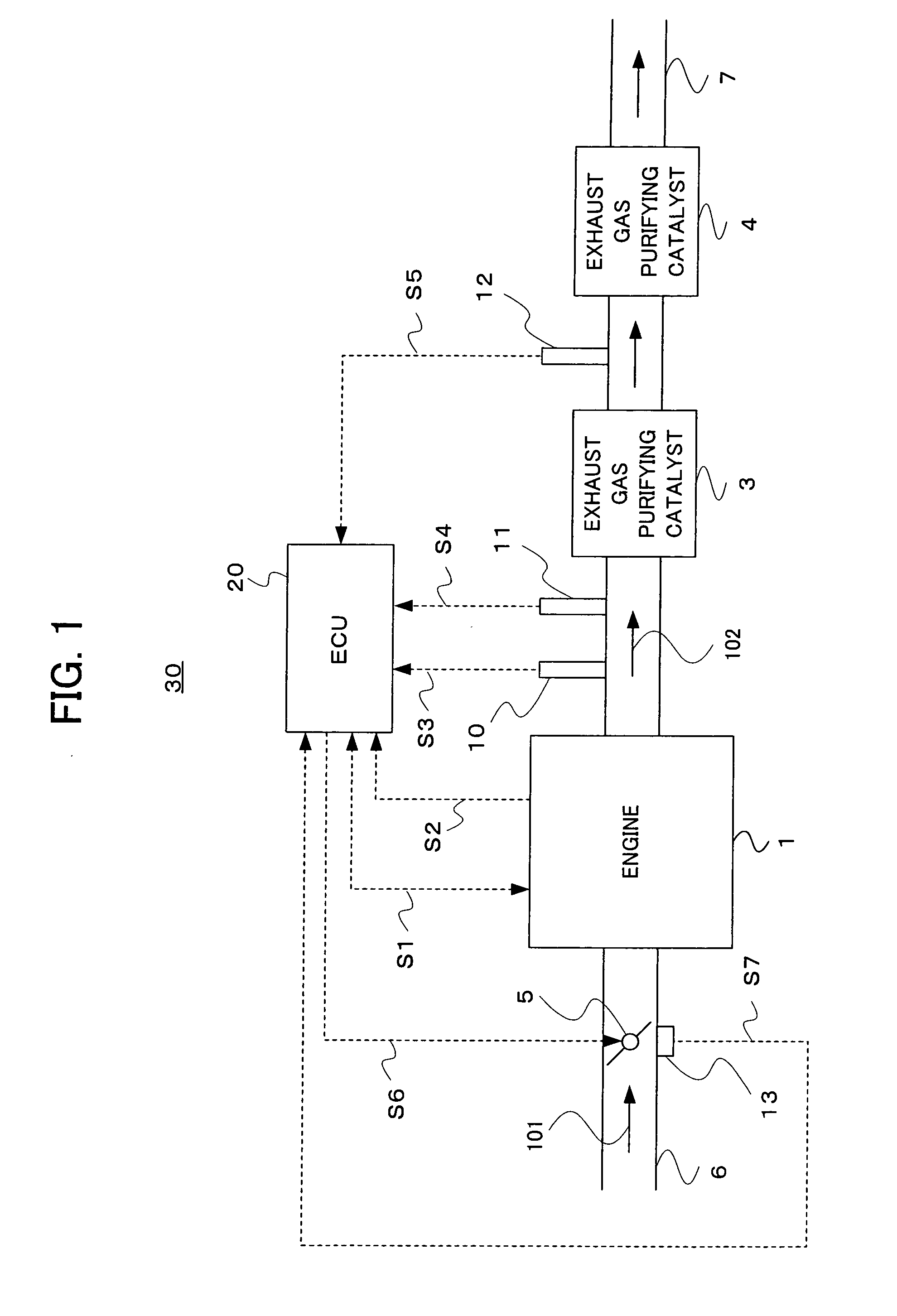Fuel cut control apparatus of internal combustion engine
a control apparatus and internal combustion engine technology, applied in mechanical devices, electric control, machines/engines, etc., can solve the problem of bringing oxygen in the exhaust gas into an excessive state, and achieve the effect of suppressing the generation of exhaust odor and preventing the deterioration of the exhaust gas purifying catalys
- Summary
- Abstract
- Description
- Claims
- Application Information
AI Technical Summary
Benefits of technology
Problems solved by technology
Method used
Image
Examples
first embodiment
[0036] First, fuel cut processing according to a first embodiment of the present invention will be explained with reference to a flow chart in FIG. 4. The fuel cut processing according to the first embodiment intends to perform fuel cut while suppressing generation of H2S causing exhaust odor and preventing deterioration of the exhaust gas purifying catalyst. The fuel cut processing is executed by the ECU 20 controlling a fuel injection valve (not shown) in the engine 1 and making the fuel injection rate zero. The fuel cut processing explained below is repeatedly carried out at predetermined cycles during operation of the engine 1.
[0037] The ECU 20 firstly determines whether a present number of engine revolution NE is equal to or higher than a predetermined number of engine revolution NE0 or not in step S11. The ECU 20 obtains the number of engine revolution NE from the signal S2 outputted from the engine 1. The predetermined number of engine revolution NE0 is stored in a memory or...
second embodiment
[0053] Fuel cut processing according to a second embodiment also performs fuel cut in consideration of the maximum oxygen storage amount Cmax of the exhaust gas purifying catalyst 3 and the temperature T of the exhaust gas purifying catalyst 3 as in the fuel cut processing according to the first embodiment. However, in the fuel cut processing according to the second embodiment, when the maximum oxygen storage amount Cmax of the exhaust gas purifying catalyst 3 is equal to or larger than the predetermined amount C0, the fuel cut is performed only in the necessary range for preventing the generation of the exhaust odor, and thereby the deterioration of the catalyst is prevented. The fuel cut processing according to the second embodiment will be explained hereinafter by using a flow chart shown in FIG. 5. The fuel cut processing is performed mainly by the ECU 20.
[0054] The processing in step S20 and step S21 are the same as the processing in step S11 and step S12 shown in FIG. 4. Name...
modification example
[0064] A modification example concerning the fuel cut processing of the above-described second embodiment will be explained. The fuel cut processing according to the modification example will be shown in FIG. 6.
[0065]FIG. 5 showing the fuel cut processing according to the second embodiment differs from FIG. 6 showing the fuel cut processing according to the modification example only in the processing of the case in which the temperature T of the exhaust gas purifying catalyst 3 is lower than the predetermined temperature T0 (step S27; Yes and step S37; Yes). In the second embodiment, the target time TFC0 in which the fuel cut is continued is calculated only when the maximum oxygen storage amount Cmax of the exhaust gas purifying catalyst 3 is equal to or larger than the predetermined amount C0 (step S22; Yes), but in the modification example, the ECU 20 also calculates the target time TFC0 in step S33 when the temperature T of the exhaust gas purifying catalyst 3 is lower than the ...
PUM
 Login to View More
Login to View More Abstract
Description
Claims
Application Information
 Login to View More
Login to View More - R&D
- Intellectual Property
- Life Sciences
- Materials
- Tech Scout
- Unparalleled Data Quality
- Higher Quality Content
- 60% Fewer Hallucinations
Browse by: Latest US Patents, China's latest patents, Technical Efficacy Thesaurus, Application Domain, Technology Topic, Popular Technical Reports.
© 2025 PatSnap. All rights reserved.Legal|Privacy policy|Modern Slavery Act Transparency Statement|Sitemap|About US| Contact US: help@patsnap.com



